As I approached the ruins, a feeling of ancient history overtook me. I experienced a sense of family. It was strange to realize I was walking in a place where my ancestors had lived for such a long time. It was chilly. Every once in a while a little drizzle fell upon me, but I was in no hurry to leave. The place had put a spell on me. Even after returning home to North Carolina, I felt a pull or urge to learn all I could about the castle, the village and the people who lived there. I found a book that had been written about the first Roger by an English historian. And, of course, the internet is a great source for furthering my research.
One of the reasons for our trip to Great Britain was to look for places where our ancestors had lived before. I had studied our family history and poured over maps before we actually traveled so we could stay near places we wanted to visit. I had located several places and we were excited to find them. While we visited many places, Wigmore stands out far above all the others and found a special place in my memories.
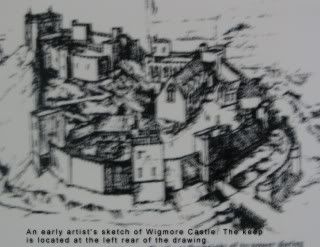
It was a cool, cloudy day in Herefordshire, England when we set out to find one of our ancestral homes. Wigmore Castle is located in the northern corner of Herefordshire, together with the ancient village bearing the same name. The castle site is located on a spit of land at the end of a row of hills pointing out into a fertile valley. When the castle was inhabited the valley consisted of marshlands to its diagonal north and a backdrop of thick forest-covered hills. Today this marsh, together with its accompanying lake, has been drained; the result of the need of later generations of owners and tenants to extend land suitable for cultivation. In the castle's hey-day, however, this wetland provided inhabitants with ample supplies of fish and game, as did the forest on the remote side of the ridge.

Centuries of decay, neglect and attackers' efforts have now left the castle a scattering of ruins with features such as towers, curtain walls and a barely discernable gatehouse, for the visitor to carefully view due to their deterioration and the growth of heavy vegetation. Things should not get any worse as the current owner, Mr. John Gaunt, has handed over the site which defines Wigmore, in guardianship to English Heritage. This national agency has the responsibility for the conservation of historical sites. Work, of both research and a stabilizing nature, has been completed.
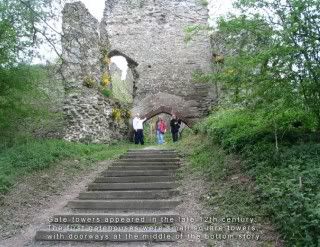
The site of Wigmore Castle is located on the remains of an earlier fortification. The age of this structure, built on a piece of land called Merestun, is not clear, but it is known that to be of very early origin, having been repaired and held by Edward the Elder in 921. Vikings later attacked this fortification, but were defeated. The village close by was called Wigingamere.
At the time of the reign of Edward the Confessor, (about 1042 – 1066) the barony of Wigmore belonged to Edric Sylvaticus, the Saxon Earl of Shrewsbury. He refused to submit after the Norman Conquest and was defeated in battle and taken prisoner. His possessions were subsequently granted to William Fitz Osbern, the Earl of Hereford under William the Conqueror (1068 to 1072), as a reward for his services.
Among these possessions were the remains of the earlier fortification on Merestun. Fitz Osbern subsequently rebuilt Wigmore Castle, as it became known. Although it was initially only a small castle built of earth and timber, it was to become one of the main English border castles along the Welsh Marches. The Welsh Marches is a term used to describe the counties along the border with Wales, mainly on the English side during the 13th and 14th centuries.
Fitz Osbern's son Roger de Breteuil took part in the Revolt of the Earls. The Revolt of the Earls in 1075 was a rebellion of three earls against William the Conqueror. After the Earl's subsequent defeat William seized the castle and gave it to another of his supporters, Ranulph de Mortimer. From this time on Wigmore became the head of the barony of the Mortimers, Earls of March.
Some time after 1135, the castle was rebuilt (still with timber) on a larger scale by Ranulph's son, Hugh de Mortimer. The new structure included a large motte. A motte in French is a raised earth mound, like a small hill, topped with a wooden or stone structure known as a keep. The earth for the mound would be taken from a ditch, dug around the motte or around the whole castle. The outer surface of the mound could be covered with clay or strengthened with wooden supports. There was an enclosed bailey or large courtyard to the southeast. At this stage the buildings and defenses are still made of timber. In 1155 the castle was besieged by Henry II because of Hugh's support for Stephen of Boulogne. Two small earthworks to the east and west of the castle have survived to the present day. These were probably siege-works built for the campaign.
In 1181 Hugh's son (also called Hugh) began to rebuild parts of the castle in stone. This process was completed by 1246 by Hugh's grandson, Ralph de Mortimer. This included the curtain wall that surrounds the bailey, which still stands to this day at its full height on the east side and the south side between the south tower and the gatehouse.
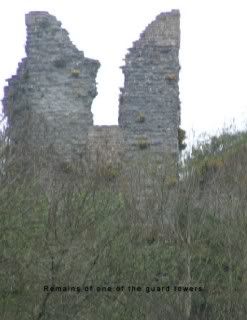
In 1304 Roger de Mortimer, (my thirtieth great grandfather) succeeded his father Edmund. He strengthened the position of the Mortimer family considerably, eventually becoming Isabella of France's lover. To further complicate the situation Isabella was also the wife of Edward II, King of England. Roger became a trusted advisor to Edward II and eventually became very powerful. But he allowed greed to overcome his good sense. Roger and Isabella plotted to overthrow Edward II. Edward II became aware of the plot and had Roger thrown into the Tower of London. Some of Roger’s supporters managed to bribe a keeper in the Tower who allowed Roger to escape. (Roger is only one of two people who ever successfully escaped from the Tower of London.) Roger’s friends were waiting for him in a small boat on the Thames and helped him escape to France. Once in France he began to plot and work to get Isabella to make a royal visit to her family who were the current rulers of France. She managed to get Edward II to allow the visit. She then joined up with Roger. They raised an army of about ten thousand men. Soon they invaded England and captured Edward II. Here the story becomes a little murky. Some historians say, Roger had Edward killed, while others say he had Edward banished to a castle in Scotland where he was imprisoned until his natural death. At this point Roger also acted as Regent for Isabella's son (later Edward III) while he was still a minor. This was for a period of four or five years. During this time, Roger also rebuilt Wigmore Castle in its present form. Wigmore became a scene of many royal tournaments, parties and great revelry.
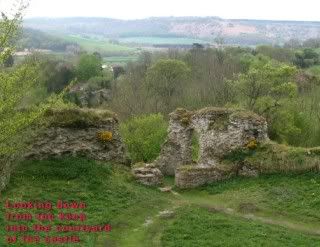
In 1330 Edward III succeeded to the throne and had Roger de Mortimer once again imprisoned in the Tower of London. This time there was no escape and Roger was executed. While many of Roger’s holdings and riches were seized by Edward, he allowed Mortimer's grandson (also named Roger) to keep Wigmore Castle.
This Roger became a trusted royal servant of Edward III and because of this he was able to have his grandfather's sentence reversed and he was restored all the Mortimer estates. His son Edmund married Edward III's granddaughter Phillipa. In 1381 their son, Roger, inherited at the age of six and was declared the heir presumptive should Richard II (Phillipa's cousin) die childless.
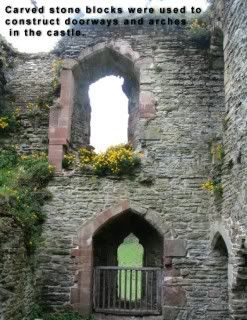
Roger de Mortimer was killed in battle in Ireland in 1398 and in 1399 Henry Bolingbroke (Henry IV) deposed Richard II and seized his throne. When the male line of the de Mortimers died out in 1424, the castle passed to the crown.
Edward, Duke of York, another member of the Mortimer dynasty, was almost certainly based at Wigmore Castle before his victory over the Tudors at the Battle of Mortimer's Cross in 1461. He eventually deposed Henry VI and was crowned King Edward IV the following year. During his reign the castle ceased to have any real significance and was barely maintained. Nearby Ludlow Castle (which the Mortimers had inherited through marriage in 1314 and was their administrative centre) supplanted it as a royal castle.
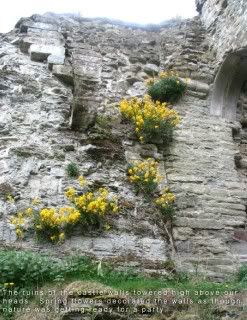
Throughout the 16th century Wigmore Castle was managed by the Council of the March, partly as a prison, although the castle was already beginning to decay.
In 1601 Elizabeth I sold Wigmore Castle to Thomas Harley of Brampton Bryan. His son, Sir Roger Harley, a Puritan and Parliamentarian, later inherited the castle. During the English Civil War, Harley left the castle in charge of his wife, Lady Brilliana, while he went off to battle for the crown. Lady Brilliana had a reputation as a fierce warrior in her own right and when she felt the castle might be taken by the Royalists she had the castle's defenses dismantled and the walls breached in order to prevent the Royalists using it as a stronghold against the Crown and her. In fact, the castle played no part in the Civil War and was already in a state of ruin by 1644, the buildings being left roofless and crumbling through natural decay.
Despite not being in a premier league in terms of size where medieval castles are concerned, Wigmore was an edifice graced with a significant degree of splendor for those years of Mortimer ascendancy, particularly in its latter two centuries. This importance was not diminished by its distance from royal courts. Its barbican (A tower or other fortification on the approach to a castle, especially one at a gate or drawbridge.) saw a whole aristocracy pass through it, and not just that of England. Welsh, Scottish and Irish nobles would variously have been visitors, probably combining political business with pleasure. Guests would also have included the envoys of many a Western European court, engaged in similar duties and celebration.
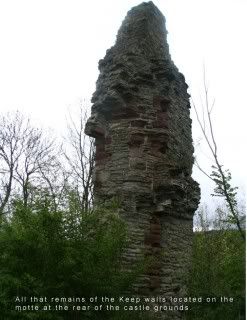
The manner in which these noble guests were hosted would have been sumptuous. There would have been no fear, on the incumbent family's part, of the welcome offered not being to the level to which the guests were accustomed. The castle's environs provided all that was required in ordinary fare, and the family was rich enough to import the more exquisite items of the hall's board. The same would have applied to the furnishings and decor, and also to the service that the family would be offering to the aristocratic arrivals. Entertainment too was varied, particularly in the field of tournament. Here, events were on a massive scale - on one occasion the grandfather of the infamous Roger, of the same name, provided a spectacular participation and viewing for a hundred knights and their consorts for three days.
As I sat high on that hill, alone among the ruins of the castle keep, I imagined I could hear the voices of my ancestors. In my mind’s eye I could see that young boy who would become a ruler of England. I could see him learning the basics of becoming a knight. I could see him with his boyhood companions, riding his charger, playing at jousting; polishing his skills to be the warrior his family expected him to be. I see him at the early age of fifteen being married to a young girl to unite two powerful families. As the years go by the castle evolves into a “happening place” where the rulers of the world gather to decide the affairs and futures of the known world. A great sense of history filled my mind and lifted me into those long ago days. As I walked down the hill through the ruins of walls, towers, moats, and living spaces, I kept looking back, feeling a sorrow at leaving that I couldn’t comprehend.


Great post! I recently visited Wigmore for an essay I am writing at university- 'Making heritage relevant: the case for Wigmore Castle' I am including some of your comments about how it made you feel.
ReplyDelete